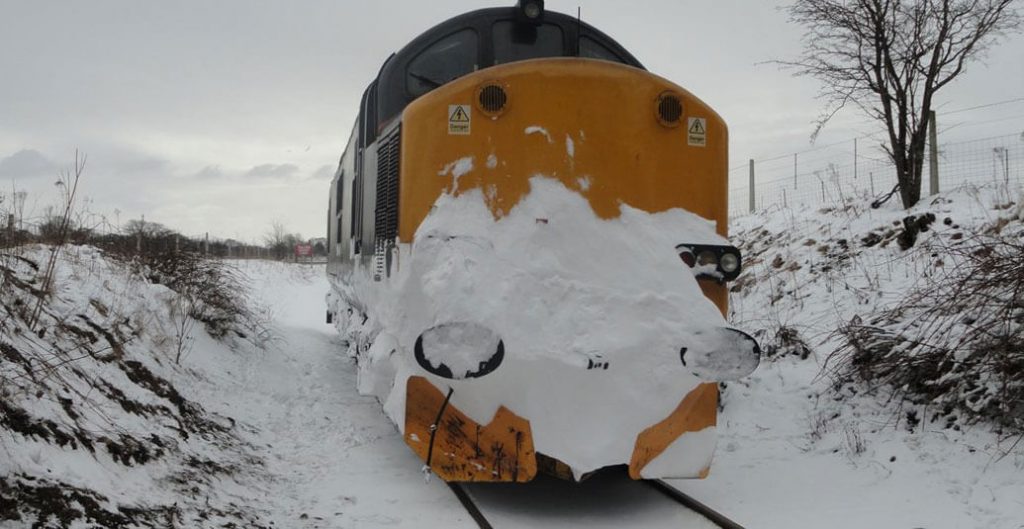How we evaluate and respond to the day-to-day challenges of weather.
From keeping on top of daily wear and tear to putting right the more extreme damage caused by floods and landslips, weather is a constant source of challenge.

Where possible, we use the latest technology (such as visual and thermal imaging from our helicopter and drones) to monitor when and where weather is likely to cause these kinds of problems so we can either prevent them or respond quickly to restore normal, safe service.
We also have specialist machines which help our engineers keep the railway running whatever the weather. We work year-round to prepare for changing seasons and to make sure that we learn from previous incidents to reduce the impact in the future.
Find out about the weather challenges we face on our Delays Explained pages
Jump to
Weather forecasting
We have a bespoke weather forecasting service to allow us to plan for incidents that could affect rail travel. Before 03:00 every day, we receive detailed weather forecasts and alerts for routes and local areas. Our route operations teams can plan the response needed over and above our planned seasonal preparation based on the following statuses:
- Normal conditions
- Be aware
- Challenging weather
- Extreme weather, when a reduced timetable and redeployment of resources may be needed
- Extreme weather is a problem across two or more of our 14 routes
Improving our forecasting
We’re developing ways to achieve a more detailed forecast of rainfall across eight square kilometres, rather than the current 16, and improving our radar so that it can predict the movement of rain or thunderstorms six hours into the future, as opposed to the three hours it can predict now.
How we learn from past experience
Analysing any failures of assets on the railway in conjunction with weather data from the same period in previous years helps us understand how different weather scenarios can be predicted, and prepared for.
Hot weather reports
Our Extreme Heat Task Force (EHTF) was launched in July 2022 in response to record temperatures which caused significant disruption for passengers. The remit of the EHTF is to assess how our network resilience can improve in these conditions and how other countries manage these conditions more effectively.
A series of independent reports were commissioned by the EHTF in response, which form part of our wider response to mitigating extreme weather.
Network Rail chief executive Andrew Haines said: “Climate change, and its associated extreme weather, is the biggest challenge our railway faces. The extreme heat of July 2022, where air temperatures exceeded 40 degrees and rail temperatures over 60 degrees, were unprecedented and the railway did not cope well. As a result, I created an extreme weather resilience task force, bringing in world-renowned experts, to help us be better prepared for the future.
“Their recommendations are already well in hand and over the next five years we are significantly increasing our investment in this area to help make our railway more resilient. We will never beat Mother Nature, but we can be better prepared and mitigate the worst that she will throw at us to keep passengers and services safe and moving.”
Reports
Sir Douglas Oakervee, 139th president of the Institute of Civil Engineers with over 60 years of experience as a civil engineer. Sir Douglas has helped us to improve the performance of railway infrastructure during hot weather.
Dame Julia Slingo FRS, former chief scientist at the Met Office and a world-renowned expert in climatology. Dame Julia reports on how we can improve our weather forecasting to help mitigate the impact of heat on our infrastructure.
Independent transport watchdog Transport Focus. Anthony Smith, in his role as chief executive, examined how we communicate with and care for passengers in the run-up and during periods of extreme weather, as well as our planning for disruptive incidents.
Simon Lane, former managing director and chief executive of railways in Melbourne and New South Wales respectively. Simon has reviewed our operational standards, policies and practices that could allow services to continue to operate safely without implementing speed restrictions in the extreme heat.
Findings
In total the reports make 91 recommendations that draw out some key themes;
- Our operational response to extreme heat is too reactive. We need to pivot our thinking –using forecasts to identify risk, deciding the service we want to run and targeting our resources proactively (rather than reactively responding to asset failures after the event).
- There are gaps in the capability of Network Rail’s engineers that contribute to reduced asset resilience. Increasing our engineering and asset management oversight with better direction of maintenance activity will lead to better passenger outcomes.
- We must continue building our internal weather expertise/capability and set rail specific thresholds for extreme heat based on the risk to our assets and the requirements of our passengers.
- We can improve the quality and timeliness of the information given to passengers in advance of disruption and consider what further action we can take to improve their experience during disruption.
The reports’ recommendations are now subject to detailed action planning by different Network Rail departments. To make sure that our plans reflect a passenger focused, system wide approach we will include delivery of these plans within the scope of the WRTF. We will work with report authors to make sure these plans achieve the intent of their recommendations and share our plans with the Office for Rail and Road to help them monitor our progress.